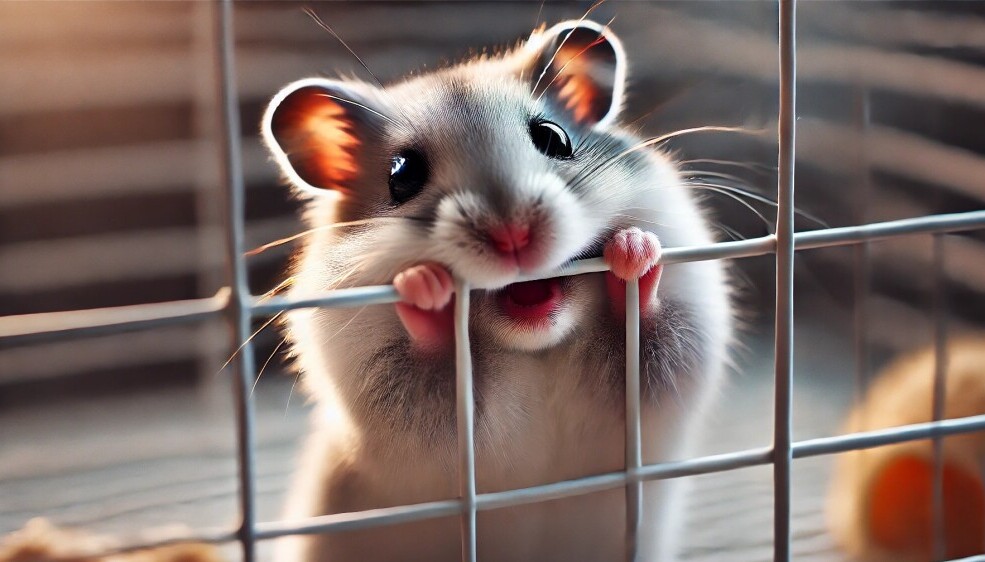Stress in dwarf hamsters is something every pet owner should be aware of. These little creatures can show signs of distress in many subtle ways. Recognizing these signals early can help you make changes in their environment, ensuring your pet stays happy and healthy.
Recognizing Stress in Dwarf Hamsters
Dwarf hamsters express discomfort through changes in behavior and physical cues. Being alert to these signs makes it easier to make adjustments in their living space. Stress signs might come from boredom, fear, or an unsuitable environment. It is common for hamsters to use repetitive actions when they are upset. These actions do not just indicate that something is off. They can point you in the right direction for solutions.
Understanding these stress signals is key. Once you know what to look for, you can address the causes. Sometimes, a small change in the cage setup or playtime routine can make a big difference. This section explains some common behaviors that might show your hamster is feeling under pressure. By observing closely, you can build a strong bond with your pet while addressing their needs.
Understanding Common Stress Behaviors
There are several behaviors in dwarf hamsters that may indicate they are stressed. Some behaviors show up as direct responses to their surroundings. When a hamster feels confined or bored, physical actions often become signs of distress. Below is a list of behaviors commonly observed in stressed hamsters:
- Bar Biting: Repeated gnawing or biting the bars of their enclosure. This might be due to boredom or a lack of stimulation, and it can damage their teeth.
- Monkey Barring: Climbing and hanging from the cage bars. This risky behavior can indicate that the hamster might be seeking more stimulation or a larger space.
- Cage Pacing: The hamster moves back and forth along the edges of the cage continuously, suggesting anxiety or frustration.
- Screaming and Hissing: Loud, high-pitched noises or hisses usually signal fear. It is a direct plea for space and calm.
- Wall Scaling: Jumping against or climbing the walls of their enclosure. This can be a sign of high stress or excitement, particularly in smaller spaces.
- Biting a Human: A clear answer that the hamster feels threatened. Defensive biting is a sign of discomfort or fear.
- Unpouching: Emptying their cheek pouches unexpectedly. This behavior is sometimes an automatic response to stress or fear.
- Open Mouth: An open-mouthed stance can be a sign of fear. Your hamster might be reacting to a perceived threat.
- Teeth Chattering: A warning signal that suggests the hamster wants you to back off. This is often seen during tense encounters with other hamsters or stimuli.
- Freezing: When a hamster suddenly stops moving or hides, it indicates uncertainty or a need to assess its surroundings.
Each of these behaviors can mean a different kind of distress. By matching behaviors with potential causes, you can make practical changes that will result in a healthier environment for your pet.
Interpreting Specific Stress Signals in Detail
While the list above gives a quick overview, understanding some behaviors in more detail can provide deeper insights into your hamster’s emotional state.
Bar Biting
When a dwarf hamster repeatedly gnaws on the cage bars, it is more than just a quirky habit. Bar biting can suggest that the animal is either bored or has insufficient stimulation from its surroundings. This repetitive action is also detrimental to dental health. If you notice this, consider enriching the hamster’s environment with new toys or a larger living space to lessen this behavior.
Cage Pacing
Persistent pacing along the cage walls is another indicator of stress. Hamsters are naturally active and curious, but when they pace continuously, it is their way of expressing anxiety. This behavior might hint at a lack of mental stimulation or an environment that feels too confined. Allowing free roaming time in a safe area sometimes helps reduce this behavior.
Screaming and Hissing
Screaming or hissing signals fear. This strong reaction means that the hamster perceives a threat in its environment. It might be a new or unfamiliar stimulus that has triggered a fight or flight response. When this occurs, it is best to give the pet space while you assess the area for any noise or changes that might have caused fear.
Teeth Chattering and Freezing
Teeth chattering is a subtle warning sign, especially when introduced to new companions or if there is sudden movement in the surrounding area. Similarly, freezing can be another sign that your pet feels threatened. When your hamster stops moving and withdraws, it is a signal to step back and evaluate the cause. Giving the animal a quiet space for recovery can make a big difference in its overall well-being.
Managing and Reducing Stress
Once you have identified that your dwarf hamster is under stress, taking steps to reduce it becomes the key focus. It is important to address both the physical and emotional needs of your pet. Often, a more enriched environment can work wonders in raising your hamster’s mood. Adjusting the living space by adding tunnels, exercise wheels, and diverse toys can help provide much-needed stimulation.
In addition to environmental enrichment, regular interactions play a part in stress reduction. Spending some time near the cage in a calm manner helps your hamster feel safe. Keeping ambient noise low and surroundings neutral aids in reducing sudden shocks. Here are some steps that you can apply to help manage stress in your dwarf hamster:
- Assess the current cage environment for signs of boredom or confinement.
- Add stimulating elements like tunnels, toys, and an exercise area.
- Ensure a regular day-night cycle and consistent feeding times.
- Monitor the pet for repeated stress behaviors and adjust the environment as needed.
- Provide safe, supervised free roaming time outside the usual cage when possible.
While each suggestion might seem small, collectively they can create a positive change in your pet’s daily routine and significantly lessen stress levels.
Creating a Supportive Environment for Your Dwarf Hamster
A supportive environment plays an important role in keeping your dwarf hamster calm. The living space should not be too cramped or overly stimulating in a negative way. A balance between safety, enrichment, and routine is vital. This section discusses how to establish a balanced habitat for your pet.
Start by ensuring that your pet’s cage is appropriately sized. A larger enclosure often helps in reducing feelings of confinement. When a hamster has more space, it naturally finds room for varied activities that keep it occupied. Moreover, offering a mix of hideouts, nesting materials, and climbing structures can simulate a more natural setting, which has a calming effect.
Besides physical space, paying attention to daily routines can also reduce stress. Dwarf hamsters are creatures of habit. Maintaining a consistent schedule for feeding, cleaning, and playtime establishes a sense of security. Consider these practices when setting up an environment for your dwarf hamster:
- Appropriate Cage Size: Ensure that the habitat is spacious enough to allow free movement and exploration.
- Enrichment Tools: Use tunnels, wheels, and hiding spots to keep the hamster mentally active.
- Quiet and Stable Environment: A calm setting with moderate noise levels fosters peace in the hamster.
- Regular Interaction: Gentle interactions help the pet associate positive experience with human presence.
- Consistent Routine: A daily routine builds familiarity and decreases stress reactions to unexpected changes.
Even small improvements to their living quarters can result in noticeable changes in behavior. By continually adapting the environment based on observed stress patterns, you create a supportive sanctuary that can prevent stress from becoming overwhelming.
Frequently Asked Questions
This section covers common queries regarding stress in dwarf hamsters that many pet owners ask:
Question: What are the most common signs of stress in dwarf hamsters?
Answer: The most common signs include bar biting, monkey barring, cage pacing, screaming or hissing, wall scaling, biting, unpouching, open mouth postures, teeth chattering, and freezing. Observing these behaviors closely helps in understanding your pet’s level of comfort.
Question: How can I make my hamster feel more comfortable in its cage?
Answer: Stepping up the cage environment with extra enrichment items like tunnels, toys, and hiding spots along with ensuring a larger living space can make a significant difference. Consistent routines and calm interactions also help.
Question: Is it normal for my dwarf hamster to exhibit these stress behaviors occasionally?
Answer: A bit of stress now and then is normal as your pet adjusts to changes. However, persistent or intense behaviors may indicate a need to reevaluate their environment and daily routine. If unusual patterns continue, consider seeking advice from a vet.
Question: When should I consult a vet about my hamster’s stress?
Answer: If you notice a prolonged period of stress behaviors, significant changes in appetite, weight loss, or if the hamster seems lethargic, it might be time to consult a professional. An expert can help identify underlying issues that may not be immediately obvious.
Extra Tips for a Stress-Free Home
Creating an environment where your dwarf hamster can feel truly secure is very important. In addition to the routine improvements mentioned above, consider spending extra time observing your pet during its active hours. This extra attention can help you spot subtle changes in behavior. For instance, adjusting lighting levels, rearranging some parts of the enclosure, or even introducing a new toy gradually can have a very important impact. It can also help to schedule quiet periods during the day when there are minimal disturbances. Small modifications like these enable you to tailor your pet’s habitat to their unique needs. Moreover, keep in mind that consistency is key. Regular monitoring and experimenting with different enrichment items can help you find what works best. This commitment not only boosts your hamster’s overall mood but also reinforces the trust between you and your pet.
Conclusion
Dwarf hamsters can show their discomfort in various subtle ways. Noticing signs of stress such as bar biting, pacing, and even defensive behaviors like hissing is important for early intervention. By understanding these signals, you can tailor your pet’s environment to support better health and well-being. Regular monitoring and adjustments go a long way in easing stress.
Creating a comfortable and stimulating environment requires attention to detail and consistency. With a balanced habitat and careful observation, you can make your pet’s life much more enjoyable. Keep your hamster’s needs in focus, experiment with different enrichment tools, and always be ready to give them the extra care they may need. A little patience can ensure your dwarf hamster lives a happy, thriving life.
The adventure to understanding your pet’s behavior is ongoing. Each day provides a new learning opportunity. Small changes can make a big difference in reducing stress and fostering a supportive home environment for your dwarf hamster. Monitoring stress indicators and responding with thoughtful adjustments will help maintain harmony and health in your pet’s daily life.

